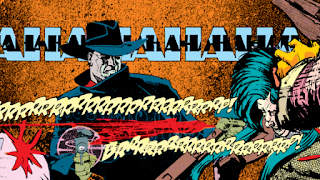Flagg was set in a nearly-conceivable future, 50 years from the then-present (2030); Chaykin's Shadow plucks a character from the 1930s and deposits him abruptly across 50 years of history into contempo-1980s NYC. In Chaykin's hands, the fascist tendencies of the title hero are brought to the fore. Although present-day characters act as an ineffectual chorus, complaining of the man's brute behavior, it is an incontestable fact that the man and his methods are right at home in this supposedly more enlightened age.
If Chaykin's stylistic and thematic template strains, or perhaps signifies the sort of growing rigidity that frequently consumes a successful "breakout" artist, we nevertheless owe him an enormous debt of gratitude for pulling the title character into the age of continuous Soft Cell airplay, and introducing rocket launchers and Uzi machine guns to our hero's arsenal.
Chaykin's deal with DC was for four issues; he moved on to more enticing projects, while DC passed the script and story-boarding reins to Andy Helfer, whose concepts were engagingly rendered into the brown acid stylings of Bill Sienkiewicz.
 |
| "Mature readership" still very much suggested. |
At the outset of his six-issue run with Sienkiewicz (Shadows & Light) Cranston-Shadow is still a grim and imposing figure. His team of operatives, however, expands to include increasingly eccentric, erratic, even pathetic characters -- most notably the pharmaceutical expert (and indulger) "Twitch" Twitchkowitz, and his paramour Gwen, a fired nurse and retired wrestler.
"The Master" might retain his unassailable and perversely beguiling sense of entitlement, but to the reader his wisdom and overall game-plan look increasingly suspect.
Sienkiewicz's star was really taking off by this time -- and so did he, to other projects (including Elektra: Assassin). Helfer followed Shadows & Light with a one-off, Harold Goes To Washington, penciled by Marshal Rogers and inked by Kyle Baker.
Harold ties up some loose ends from the earlier story-arc and does a little ground-work to situate the next, but struggles to find its "tone." It is a morbidly weird and unsettling narrative failure, frankly. But something must've clicked, because Rogers disappeared, and Helfer and Baker launched the next 12 issues into the giddy ether, doing stuff that nobody has seen -- till then or since -- in comic book pages.
 | |||
| Still "Suggested For Mature Readers" |




No comments:
Post a Comment